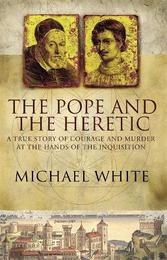
|
The Pope And The Heretic: A True Story of Courage and Murder
Paperback / softback
Main Details
| Title |
The Pope And The Heretic: A True Story of Courage and Murder
|
| Authors and Contributors |
By (author) Michael White
|
| Physical Properties |
| Format:Paperback / softback | | Pages:224 | | Dimensions(mm): Height 196,Width 126 |
|
| Category/Genre | Biographies and autobiography
Popular science |
|---|
| ISBN/Barcode |
9780349113494
|
| Classifications | Dewey:195 |
|---|
| Audience | |
|---|
| Illustrations |
Integrated: 10, Integrated b/w
|
|
Publishing Details |
| Publisher |
Little, Brown Book Group
|
| Imprint |
Abacus
|
| Publication Date |
2 March 2006 |
| Publication Country |
United Kingdom
|
Description
Giordano Bruno (1548-1600) was a mystic, philosopher and scientist whose ideas were decades ahead of their time. A proponent of a unificatory vision of science, he was both a champion of the occult as Newton would be after him, and a torch-bearer for the sort of holistic dreams that Leonardo had cherished before him. As such he is perfect material for the third in Michael White's loose trilogy of science biographies - after Newton, the last sorcerer, and Leonardo, the first scientist, we have Bruno, science's first martyr. THE POPE AND THE HERETIC re-creates not just the vibrancy of intellectual life at the height of the Renaissance but also the horrific cost of pursuing ideas which ran counter to the orthodoxy of the Catholic Church. After almost eight years' imprisonment and torture at the hands of the Inquisition, Bruno was burned at the stake for his beliefs - or rather, his refusal to accept that intellectual investigation was limited by the dictats of Rome. His life and martyrdom are the subjects of this fascinating book.
Author Biography
Michael White is a former science writer for GQ magazine. In a previous incarnation he was a member of the Thompson Twins pop group, before becoming a full-time writer in 1991.
Reviews'The Pope and the Heretic asks why, on the morning of February 19, 1600, following years of hideous torture, philosopher Giordano Bruno was led out to a stake in the middle of the Field of Flowers in Rome, to burn to death. This lucid and illuminating book is an attempt to find the answer. One reason, carefully and cleverly teased out by Michael White, author of the bestselling Leonardo: The First Scientist, is the era that Bruno was unfortunate enough to live and work in. The late 16th century was a time of savage religious and ideological conflict across Europe. A ruthlessly honest, determinedly original, exuberantly syncretist thinker like Bruno, willing to question the theological and historiographical verities espoused by the Vatican, was a noisome thorn in the flesh of a Roman Catholic Church already wrestling with Protestant dissent. Another reason, not elided by White, was Bruno's intellectually pugnacious personality. As White says, "If he had applied more cunning, as did Erasmus, he may have lived to enjoy old age. Instead, Bruno actually courted danger and controversy, confronting his enemies head-on." A third reason for Bruno's terrible fate was the Inquisition. This institution could have been expressly designed to root out someone like Bruno, who was cheerfully willing to add a dash of occultism and Greek philosophy to the pure dogma of Catholic thought. The Inquisition certainly relished Bruno's demise: after his charred corpse was brought down from the stake, the remaining flesh was pulverised with gavels and the ashes hurled to the wind, as if to nullify for all time Bruno's repellent heresies. The Inquisition failed, of course. Bruno's original and clairvoyant contributions to the fields of psychology and theology continue to resonate to this day. This elegantly concise, pleasingly readable book is a fitting memorial to such a remarkable thinker.' - Sean Thomas, AMAZON.CO.UK
|